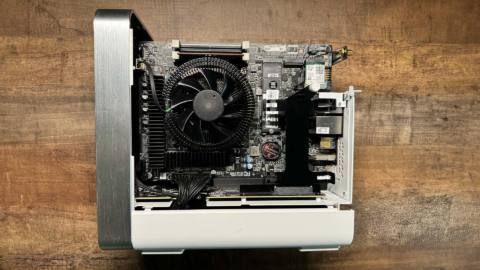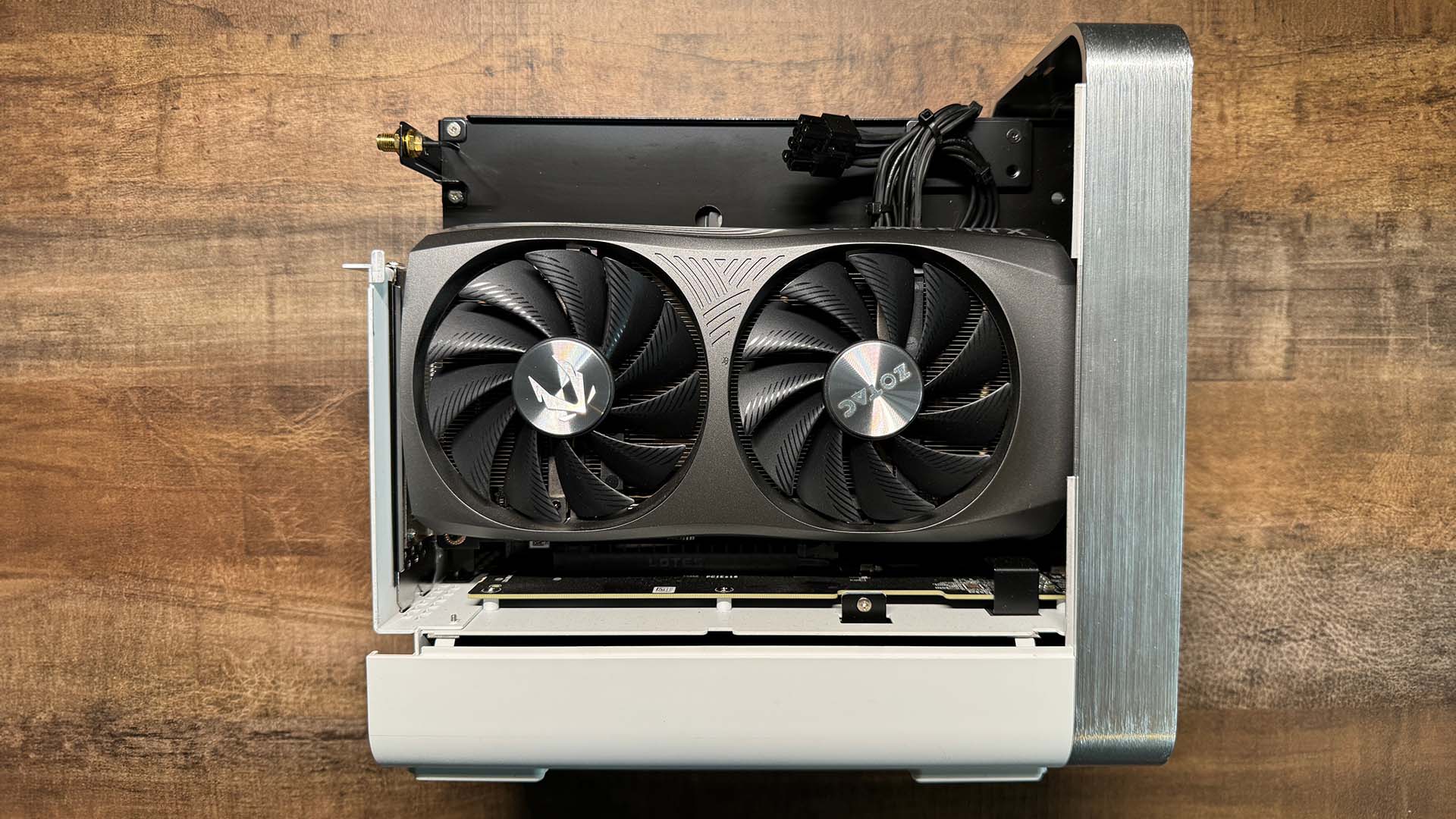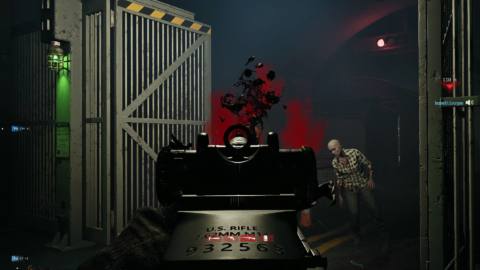Not long ago I embarked on a small form-factor odyssey with the Fractal Terra. Call me a self-flagellant, but I cherished every minute of the problem-encountering, solution-finding process. “Measure twice, cut once” they say, and that's absolutely the philosophy when you're working within such tight volume constraints. You need confidence that your GPU, CPU, and cooler, PSU and memory choices are all going to fit, and that you can adequately cool everything, before the point of purchase. Literally half the job is research and measurement. There were spreadsheets.
If you like the idea of a small form-factor PC but balk at the build, then observe the Zbox Magnus One from Zotac. With its roster of performant desktop parts, it's essentially an off-the-peg SFF PC. Regarding the form factor, it ticks two of my three boxes: it looks great, and it runs games fantastically in a compact, sub-10-liter chassis. The third is quiet operation, which is where the Magnus One stumbles, but we'll come to that in due course.
There's a lean simplicity to the Magnus One's case design which I find very attractive, achieved through the use of honeycomb panels and a minimalist front fascia. It comes in black or white, and I have to say the white sample I had in for testing was most handsome; it'd make a fine centrepiece for an uncluttered desktop with matching white peripherals.
Plus, those honeycomb panels are lined with dust-catching steel mesh too so keeping it spotless over time should involve little more than popping the panels off and blasting out the accumulated dander.

Model reviewed: ERP74070W
CPU: Intel Core i7 13700
GPU: Nvidia RTX 4070 12 GB
Memory: up to 64 GB DDR5 5600 SODIMM
Storage: 2x PCIe 4 M.2 SSD slots, 1x SATA III
Wireless: WiFi 6E, Bluetooth 5.3
I/O: front: 2x USB 3.1 Gen 2 Tye A, 1x Thunderbolt 4 Type-C, SDHC/SDXC card reader, 3.5mm headset jack
I/O rear: 2x HDMI 2.1a, 3x DisplayPort 1.4a (GPU), 4x USB 3.2 Type A, 1x USB Type-C, 2.5G LAN
Price: $1,800 (Barebones) | £1,374
Accessing the innards is a cinch. Two silicone-clad thumbscrews at the rear release the top panel, along with its two attached 92 mm case-fans and the connected rear fascia. This frees the whole arrangement to slide off as one unit, then it's just a case of popping the side panels up and out. Thus de-robed, the Magnus One's components are laid bare for additions and upgrades, with the sole exception of the flex-style PSU, which dwells in the basement and requires some more intricate lockpicking to access.
And what a solid array of components it is. On the right-hand side of the sandwich-style internal structure is the motherboard, with a full-fat desktop i7 13700 conducting the orchestra. With eight Performance cores, eight Efficient cores and a max turbo-speed of 5.2 GHz, it's an excellent gaming CPU. On the other side of the central divide is a dual-slot, vertically-mounted RTX 4070—a Zotac model, naturally—with 12 GB of GDDR6X RAM. Together, these core compute components promise punchy performance at 1440p (2560X1440) and, at a stretch, 1440p Ultrawide (3440×1440). It's a capable GPU, but not one that is apt to drive a 4K panel, so fair warning.
The unit ships barebones so you'll need to bring your own RAM and storage (or purchase the Magnus One from a retailer with a configurator and have them preinstalled) but that's fine by us; going barebones and bargain-hunting for your own extras is always the better option, and I love that Zotac supports this. The motherboard will take up to 64 GB of DDR5-5600 in SODIMM form-factor, and two M.2 PCIe Gen 4×4 SSDs plus a SATA drive as well. There's also a preinstalled Killer wireless M.2 card in the mix, which nets you WiFi 6 speeds plus Bluetooth 5.3 connectivity. All in all, a rock-solid spec-sheet.
The external IO pulls its weight too. Upfront you get a card reader, 3.5 mm combined audio jack, a Type-A USB 3.1 port and a Type-C Thunderbolt 4 port. Round the back, we find two USB 3.0 and four USB 3.1 ports, 1G and 2.5G LAN ports, another Thunderbolt socket, plus DP 1.4 and HDMI 2.1. Though really, you won't be needing these last two as the included RTX 4070's HDMI 2.1a or DP 1.4a ports are where you'll be connecting that high refresh-rate monitor.
We tested the Magnus One at 1080p and 1440p, the latter resolution being the ideal hunting-ground for midrange GPUs such as the RTX 4070. At 2560×1440, with ultra settings, DLSS, Frame Gen and Ray Tracing in those games which offer it, this machine performs exactly as you might expect given the strong CPU/GPU double-act.
Total War: Warhammer 3 is slick as you like, seeing 91 fps in battle and 89 fps in campaign, while Forza comfortably breaks the 100 fps mark with full ray tracing. As does Cyberpunk, making 109 fps , though if you're not bothered about ray-tracing, turning it off bumps the score up to 142 fps.
In other graphically-intensive titles without built-in benchmarks, we eyeballed some stellar frame rate ranges at 1440p/ultra settings, with DLSS set to balanced and Frame Gen on where applicable. Helldivers 2 gets a rock-solid 91-97 fps, Dead Space makes between 130-160 fps in the final boss battle, and A Plague Tale: Requiem's visually delightful (and conceptually harrowing) Hives level sees the Magnus One sitting pretty in a buttery-smooth 140-160 fps range.
So, it's great news on the performance front. But there's a price to be paid under gaming workloads, and it's your ears which foot the bill. There's no getting around it: The Zotac Magnus One's various cooling components generate quite a lot of noise.
The primary offender is the CPU cooler. It's a low-profile unit, and rather than the usual cooling-block-with-top-mounted-fan arrangement, the fan is sunk within the cylindrical body of the cooling-fin array. While this saves on vertical space, it generates a great deal of audible turbulence, and every RPM-change can be divined as the fan steps constantly up and down in response to CPU heat levels. It's pretty lairy, to the point where I'd want the machine under my desk rather than on it, and that would be a travesty as front-and-centre is where the svelte Magnus One deserves to be.


I do wish more PC manufacturers would make noise-reduction a third pillar of their technical design philosophy.
The case fans are next in line. They're pretty basic 92 mm models, and again very audible, being flush against the top panel of the case. The GPU fans are perhaps the least offensive, though they still noticeably add to the audio mix under load.
In an attempt to ameliorate the din, I installed Fan Control to tinker with custom fan curves and find a temperature-versus-noise sweet spot, but the app only detects the GPU fans, not the CPU or case fans. So, no dice. A scoot round the BIOS then revealed fan-stepping controls for both, and I found that capping the CPU and case fans at 50% of their max RPM made a big difference to the machine's audible volume, though they left the i7 13700 hovering around 91 °C under gaming loads. Still far from silent, and warmer than I'd ideally like for such a monster of a chip, but certainly less distracting.
I'm a stickler for quiet computing, so out of the box, I find the Magnus One a bit intrusive. Alongside performance and cooling, I do wish more PC manufacturers would make noise-reduction a third pillar of their technical design philosophy. These three variables exist in elastic tension with one another, but with the right component choices, a good balance in all three is achievable. In a perfect world, the Magnus One's public behaviour would match its elegant looks. But I strongly suspect that with an inexpensive CPU cooler upgrade, plus some adventures in undervolting and fan-curve tweaking, you could tutor the beast to behave in polite society.
The CPU cooler is 40 mm in height, and there's a further 8 mm to play with until you hit the side panel. This grants space enough to install one of the better low-profile coolers on the market, such as ID Cooling's IS-47 XT (47 mm), Noctua's NH-L9I (37 mm) or the Be Quiet! Pure Rock LP (46 mm). We didn't have these on hand to test unfortunately, but replacing the stock cooler would absolutely be my first port of call, followed in short order by swapping out the two top-mounted case fans for a pair of quiet Noctua NF-A9s or similar.


Undervolting should also be a serious consideration with the Magnus One. The i7 13700 in our test unit peaked—if not for long—at 145 W as we kicked off the Cinebench24 multicore render test, and that kind of wattage places a terrible heat-burden on low-profile coolers, most of which are rated for lower TDPs. Like it or not, there are some compromises you simply must make in SFF systems, and one of the primary ones is in your choice of CPU.
✅ You’re after a looker: Clean looks, tiny footprint, and more elegant in design than most PC cases.
✅ 1440p is your playground: The Magnus One’s CPU and GPU excel at 2560×1440 with ultra settings and Ray Tracing.
❌ You want a quiet system: In its stock form, the Magnus One generates a lot of fan noise.
❌ You plan a later upgrade to a fat GPU: The Magnus comes with – and will only accept – a dual-slot graphics card.
In my humble opinion, there are more suitable processors for small form-factor builds than the 13th-gen desktop i7, with much lower max TDP ratings. For the Fractal Terra, I plumped for the 12-core, 24-thread, 5.4GHz AMD Ryzen 9 7900, which taps out at just 88 W. Using a low-profile cooler, with the fan-curve rigged for silent running, it's actually pretty easy to keep this chip in the 70 °C range under gaming loads with nary a peep from of the cooler.
Likewise, most GPUs benefit from a tiny undervolt using MSI Afterburner. For a minimal performance reduction—and possibly a gain, depending on the card—the reduced heat generation means you can tweak the fan curve in MSI Afterburner to run at a lower RPM under full load and eliminate a good deal of noise. I daresay the RTX 4070 in the Magnus One is a prime candidate for this procedure.
Of course, we all have differing tolerance levels for noise. If you're a full-time headset user, you may not be quite so bothered, and playing with fan settings in the BIOS can certainly improve matters. Otherwise, there's no denying that the Magnus One is an aesthetically appealing machine that will get you ATX-grade frame rates at 1440p, and does so in a physical volume which can only be matched by a complicated, ground-up SFF build.






